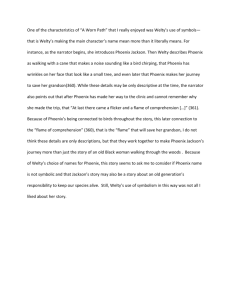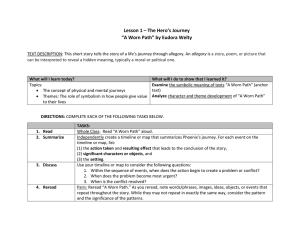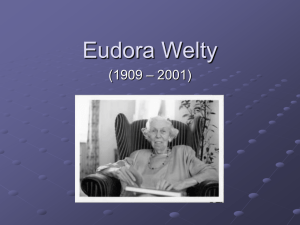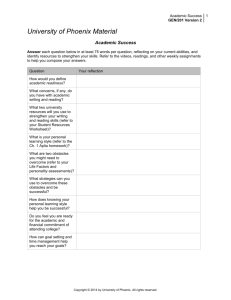Short Story Criticism | A Worn Path, Eudora Welty. The following
advertisement
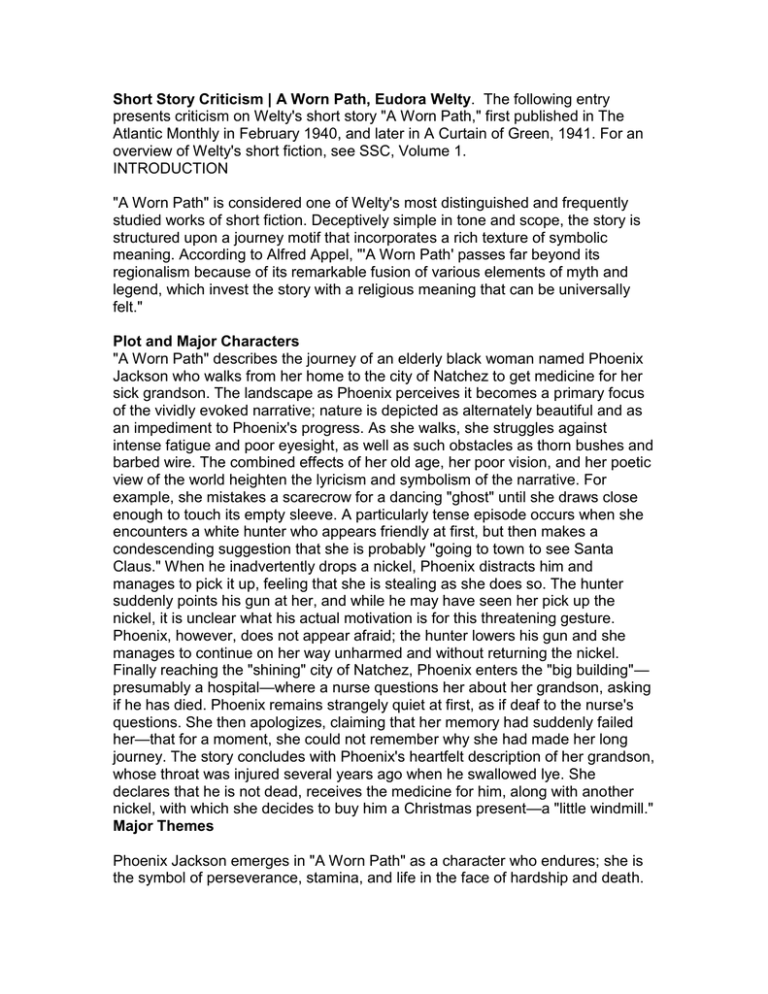
Short Story Criticism | A Worn Path, Eudora Welty. The following entry presents criticism on Welty's short story "A Worn Path," first published in The Atlantic Monthly in February 1940, and later in A Curtain of Green, 1941. For an overview of Welty's short fiction, see SSC, Volume 1. INTRODUCTION "A Worn Path" is considered one of Welty's most distinguished and frequently studied works of short fiction. Deceptively simple in tone and scope, the story is structured upon a journey motif that incorporates a rich texture of symbolic meaning. According to Alfred Appel, "'A Worn Path' passes far beyond its regionalism because of its remarkable fusion of various elements of myth and legend, which invest the story with a religious meaning that can be universally felt." Plot and Major Characters "A Worn Path" describes the journey of an elderly black woman named Phoenix Jackson who walks from her home to the city of Natchez to get medicine for her sick grandson. The landscape as Phoenix perceives it becomes a primary focus of the vividly evoked narrative; nature is depicted as alternately beautiful and as an impediment to Phoenix's progress. As she walks, she struggles against intense fatigue and poor eyesight, as well as such obstacles as thorn bushes and barbed wire. The combined effects of her old age, her poor vision, and her poetic view of the world heighten the lyricism and symbolism of the narrative. For example, she mistakes a scarecrow for a dancing "ghost" until she draws close enough to touch its empty sleeve. A particularly tense episode occurs when she encounters a white hunter who appears friendly at first, but then makes a condescending suggestion that she is probably "going to town to see Santa Claus." When he inadvertently drops a nickel, Phoenix distracts him and manages to pick it up, feeling that she is stealing as she does so. The hunter suddenly points his gun at her, and while he may have seen her pick up the nickel, it is unclear what his actual motivation is for this threatening gesture. Phoenix, however, does not appear afraid; the hunter lowers his gun and she manages to continue on her way unharmed and without returning the nickel. Finally reaching the "shining" city of Natchez, Phoenix enters the "big building"— presumably a hospital—where a nurse questions her about her grandson, asking if he has died. Phoenix remains strangely quiet at first, as if deaf to the nurse's questions. She then apologizes, claiming that her memory had suddenly failed her—that for a moment, she could not remember why she had made her long journey. The story concludes with Phoenix's heartfelt description of her grandson, whose throat was injured several years ago when he swallowed lye. She declares that he is not dead, receives the medicine for him, along with another nickel, with which she decides to buy him a Christmas present—a "little windmill." Major Themes Phoenix Jackson emerges in "A Worn Path" as a character who endures; she is the symbol of perseverance, stamina, and life in the face of hardship and death. Commentators have noted that her sheer fortitude in making the long journey on foot and alone points to these qualities, as does the mythological significance of her name, Phoenix—an Egyptian bird symbolizing resurrection. Christian symbolism is also apparent in the narrative. For example, the fact that the story is set during the Christmas season has led some critics to associate Phoenix's journey with that of a religious pilgrimage; her selfless concern for her grandson is interpreted as representing the true spirit of giving and self-sacrifice. While much of the story's substance rests on the imagistic and symbolic use of language, the action of the plot also shows Phoenix in direct conflict with the outside world—a society run by white people who have little respect or understanding for her situation. A man hunting in the forest assumes that she is going to town merely "to see Santa Claus," while a nurse dismisses her as a "charity" case and offers little sympathy for the plight of Phoenix's sick grandson. Because the story is completely free of authorial intrusion or explanatory commentary, the images and events that occur in the narrative remain open to a variety of reader interpretations. Critical Reception Critical discussion of "A Worn Path" largely has been concerned with thematic interpretation of the work, particularly the story's racial, mythological, and Christian motifs. Focusing predominantly on the story's Christian motifs, Neil D. Isaacs viewed Phoenix's Christmas journey as a "religious pilgrimage" with an ironic end that suggests "greed, corruption, cynicism." Also emphasizing Christian themes in the work, Sara Treeman pointed to story's theme of selfsacrifice, noting that the worn path "is worn because this is the symbolic journey made by all who are capable of self-sacrifice, of whom Christ is the archetype." The presence of secular mythology in the text has also been the subject of discussion by such critics as Dan Donlan, who perceived the prominence of the Egyptian myth of the Phoenix in the structure and symbolism of the story. Frank Ardolino argued for a conflation of mythological and Christian interpretations of the work, showing how "along with the Christian motifs of rebirth, the cycles of natural imagery presented create the theme of life emerging from death." The racial element of "A Worn Path" has also been a subject of critical discussion. William Jones commented in 1957 that "[t]he main reason that Miss Welty chose a Negro seems to be that only a relatively simple, uncivilized individual is worthy of representing the powerful forces which inspires such love as hers for her grandchild." John R. Cooley, in contrast, argued for a broader social reading of the story, criticizing the sentiment of the work and accusing Welty of failing to "develop her racial portraits with sufficient sensitivity or depth." Nancy K. Butterworth responded to Cooley's assessment and others with the observation that "[s]uch polemical demythologizings conflict with Welty's persistent refusal to use fiction as a platform, particularly for political or sociological issues, as well as her downplaying and even disavowal of racial implications in her stories." HW- The Great Quiz Due Dates: HW/CW Category- score varies based on number of questions per assignment. Great Quizzes are based on the Kathyrn VanSpanckeryn document which is located on my website under the ‘my resources’ tab. http://teachersites.schoolworld.com/webpages/CPerry/ Chapter 1 Chapter 2 Chapter 3 Chapter 4 Chapter 5 Chapter 6 Chapter 7 Chapter 8 Chapter 9 Chapter 10 Monday, Feb. 8th Monday, Feb. 22rd Monday, March 8th Wednesday, March 24th Tuesday, April 12th Monday, April 26th Monday, May 3th Monday, May 10th Monday, May 24th Friday, June 4th Overall Writing Goal – The Complete Critical Analysis Essay 1 A critical Analysis of ‘A Worn Path’ by Eudora Welty In Class Essay Test Monday, January 25, 2010 500 points- writing category.

